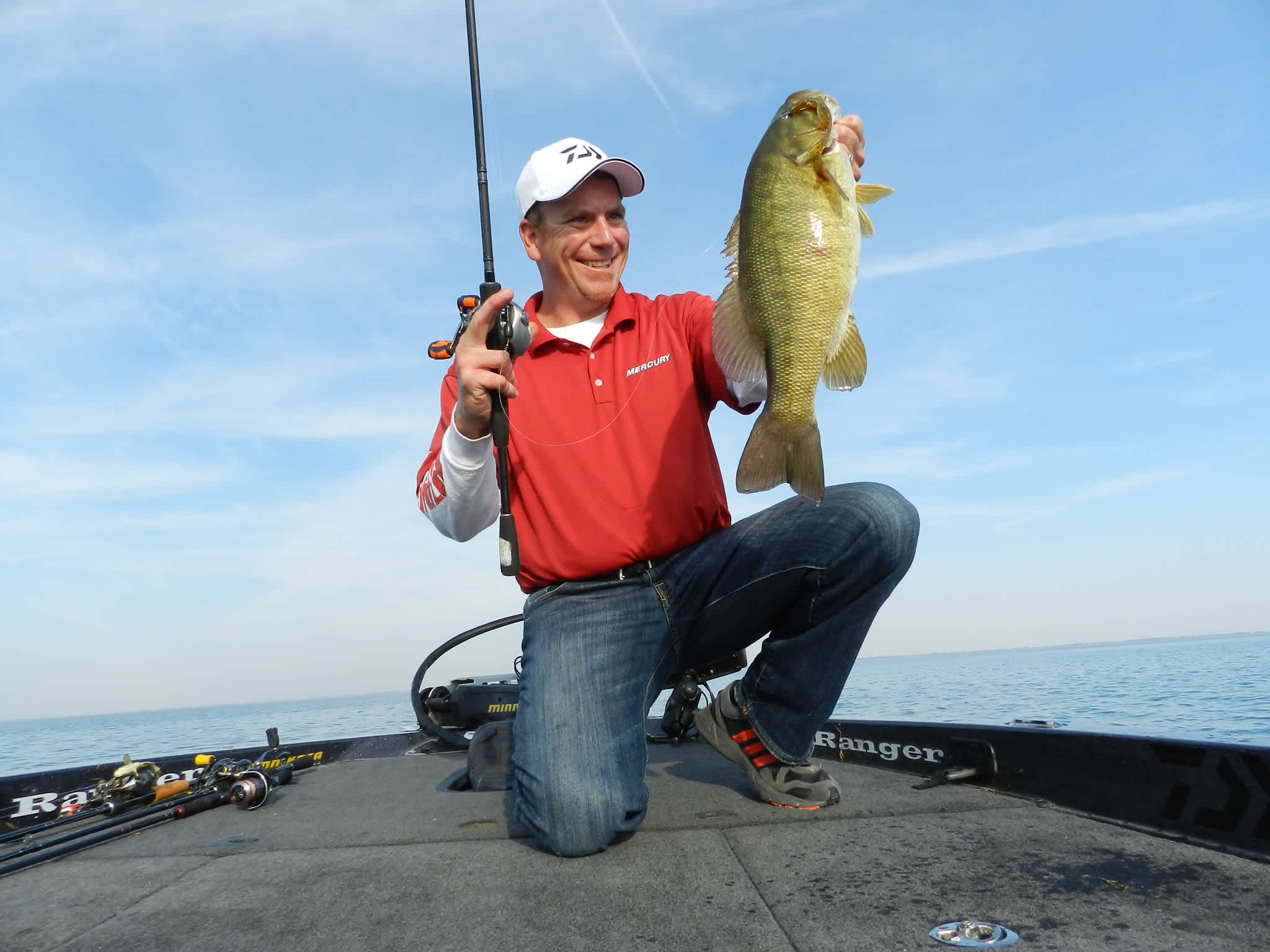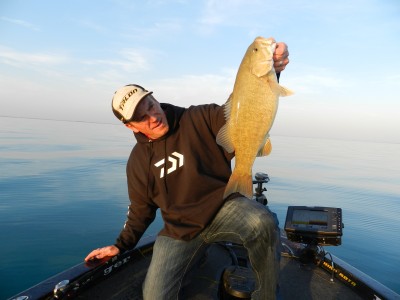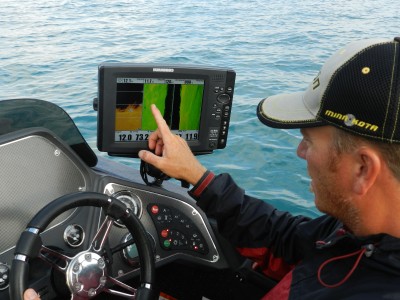Drop Shot Fishing for Summertime Smallmouth
OutdoorHub Contributors 08.23.13

Tournament bass fishing probably drives general fishing trends more than any one source. Winning a bass tournament on a particular lure often causes sales of that product to skyrocket, making lucky manufacturers overnight millionaires. And quite frequently, techniques that dominate the tournament scene often overshadow those that dominate local fisheries. Such is the case on Michigan’s portion of the Great Lakes.
Lakes St. Clair and Erie, as well as their connecting Detroit River, have been the host of countless bass tournaments over the last decade. Many of these events reached national acclaim for the giant stringers of smallmouth bass brought to the scales. Although dozens of techniques catch bass year-round in Michigan, all of the major tournaments have been dominated by one technique: the drop shot rig. Fishing drop shots is nothing new. It was a technique born out of necessity to catch lethargic fish, whether they were heavily pressured or in a seasonal funk. But, in the case of drop shot rigs being utilized on our Great Lakes, a few key modifications and methods are necessary.
To understand how to fish a drop shot, we must first understand exactly what the rig is, and what it offers that other rigging systems do not. Basically, a drop shot consists of a fairly heavy sinker (usually 1/4- to 1/2-ounce) placed on a line about 18 inches beneath a rigged plastic. The lure is tied on the mainline but, instead of clipping off the tag end after tying, a sinker is placed there, thus placing the sinker below the bait. This is where a drop shot differs from nearly every other soft plastic rigging system popular for bass—whether it’s a Texas rig, Carolina rig, or even simple jighead rigging—in most other rigs the weight is above the soft bait. Not so with a drop shot.
Having the weight beneath the bait offers two distinct advantages. First, all of the action imparted from the line goes directly to the lure, and anglers can shake and jiggle the lure without actually moving it forward. This is a major advantage for catching lethargic bass. And, secondly, it allows the lure to drop straight down to the bottom, which is just as important.

I began drop shot fishing for smallmouth on Lake Erie in the mid-nineties. At the time, drop shot fishing was gaining popularity across the bass scene, most notably in California. Few had adapted it to our local waters, where bass fishing techniques were dominated by dragging tube lures. However, as the round goby entered our waters, I began to notice that the smallmouth bass became less nomadic. They now hung around rockpiles and other structures all the time, and were often very predictable as to their location, usually favoring sharp drop-offs and the crown of underwater humps. My main problem was accurately presenting a lure to them in the turbulent waters of the Great Lakes, and triggering them to bite during the summer tournament season. The drop shot solved these problems.
Because bass tournaments are limited to Michigan’s brief bass season, the events focus on the months of July through September. During that time, smallmouth are holding on the deepest structure of the year, and warm summertime water temperatures often have them lethargic. A drop shot fits the bill perfect, as anglers can place the bait directly on fish-holding structure, even in fairly rough seas, and hold the bait in place, teasing the sluggish fish to bite. West Coast drop shotters fish light weights, and, in relatively decent weather, a 1/4- or 3/8-ounce sinker may suffice. But, in the deepest, roughest basins of the Great Lakes, 1/2-ounce weights are not uncommon.
The key, again, is to place the lure in the exact location where the fish are holding. Most often this is the place with the most drastic structure or boldest rock pile. Plastic lure choices range from small goby imitators to large shad-style baits. In recent years, super-soft Japanese imports, like those made by Jackall and Yamamoto, have taken center stage in the Great Lakes smallmouth world. Fish each on a moderately limber rod of high sensitivity. I utilize a Daiwa Steez for it’s unparalleled lightness and feel—this is the time to buy the best rod you can. And, for drop shot fishing, the lightest lines are the best. Fluorocarbon, ranging from five to eight-pound test, reigns supreme. Lately, many anglers are using braided main lines with a fluorocarbon leader for drop shot fishing. This is a great alternative for St. Clair, where the braided lines more easily pop free of the lake’s dense vegetation.
Throughout the year, many artificial baits are often more productive than drop shot rigs for our Michigan smallies. In the spring, marauding bass cruise the shallows, and can be easily caught on lipless crankbaits, jerkbaits, and tubes. Late fall fishing brings a great bite on lipped cranks, as well as the timeless Silver Buddy-style blade bait. But, during the dog days of summer, when the big money tournaments come to town, a drop shot rig reigns supreme. Here in Michigan, early spring bass are aggressive as they fatten up for the upcoming spawn. In fall, bass need to once again eat like pigs to prepare for winter. But the summer period offers them a time when their food requirements aren’t nearly as drastic. Oftentimes, for that reason, the super-finesse drop shot application is the only way to catch them.

Two other pieces of equipment that are equally important in summertime structure fishing for Great Lakes smallmouth are the proper trolling motor and GPS unit. I have been using a long-shaft, 52-inch Minn Kota trolling motor for over two decades; it’s a motor that nearly every Great Lakes pro uses. With over 100 pounds of thrust, it can hold my bass boat above a productive area in giant waves, once the practice is perfected. I combine that with a Humminbird GPS unit on both the front and rear of the boat. I need to be able to see exactly where I’m at all the time—at times the magic piece of structure is just the size of a table, and I’ll be hovering 40 feet above it in five-foot waves. Staring at the most accurate GPS available is a necessity.
When fishing the big waters of St. Clair and Erie for summertime bass, it’s important to concentrate on the deepest waters available. On St. Clair, that may be 20 feet deep, but on the west side of Erie, that’s often 35 feet or more. Rocky structures and reefs are a great place to start when available. On St. Clair, however, drastic structure is not exactly commonplace. For that reason, anglers need to key on the subtle structure there that holds big smallmouth. Time and time again, these are often bare, hard spots in miles of submergent weeds. The main lake grassbeds on St. Clair are often composed of “sand” grass, a low, course weed that grows about a foot off the bottom. These weedbeds are favorites of small perch and crawfish—some of the favorite food of smallies here. In addition, gobies often live on or near the bare sand areas mixed throughout the grassbeds. Such an “edge,” although not nearly as drastic as a major reef on Erie, for example, attracts the smallmouths to these productive feeding areas. Presenting drop shots to them is efficient and easy—the bait gets down to the bottom immediately, unlike a crankbait, and it provides a subtle presentation of a light plastic, lazily drifting through the water column, unlike the bottom dragging presentation of other rigs. The smallmouths of summer can’t resist.
As we hinted to previously, rocky reefs in the major basins of western Lake Erie can be key spots to drop shot fish summer bass. Here, the fish have moved into the deepest immediate areas, and are provided with a natural current flow. Although relatively close to Michigan ports, these structures often lie in Canadian waters, so anglers should research all of the border crossing and license requirements. With modern chartplotting units and a Lakemaster chip of Michigan, anglers can make a trip to the very best areas of the reef the first time out. Key on areas with the sharpest, most drastic depths changes, or those where the reefs rise the highest. Once fish are marked, fish vertically with a drop shot rig. I designed the first-ever goby lure for drop shot fishing, and these still take their fair share of Erie bass. The crude goby lures of yesterday, however, are being overshadowed by the magical handpours from Japan, so be sure to take a fair share of each. Again, the key lies in a subtle presentation in exactly the right spot.
Many recreational anglers have been reluctant to try drop shot fishing, favoring, instead, to continue to utilize productive spring tactics all year. When summer brings about the “slow periods,” however, these anglers often struggle, wondering what happened to the easy fishing of spring. It’s during those times when a drop shot can open up a whole new angling opportunity, and allows you the best opportunity at a summertime trophy.
This article was previously printed in Michigan Out of Doors Magazine‘s July/August edition.

